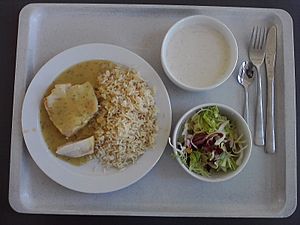Blue grenadier facts for kids
Quick facts for kids Blue grenadier |
|
|---|---|
 |
|
| Scientific classification | |
| Synonyms | |
|
The blue grenadier is a type of fish also known as hoki, blue hake, or New Zealand whiptail. Its scientific name is Macruronus novaezelandiae. This slender, silvery fish lives in the ocean around southern Australia and New Zealand. You can also find it off the coasts of South America, from Peru to Brazil.
Blue grenadiers live deep in the water, usually between 10 and 1,000 meters (about 33 to 3,300 feet) down. They eat small squids, crustaceans (like shrimp), and other fish. These fish can grow quite long, typically between 60 and 120 centimeters (about 2 to 4 feet). The blue grenadier's meat is white and often sold as fillets. It is known as a "whitefish" in cooking.
Hoki in Our Food
The blue grenadier, or hoki, is a very important fish for food. Many supermarkets in Australia sell hoki products. You might find it in pre-packaged meals or as processed fish. Often, the fish meat is shaped like a cutlet, then covered in batter or breadcrumbs. This makes it look fresh and tasty.
You might have eaten hoki without even knowing it! It's one of the fish used in McDonald's Filet-O-Fish sandwiches and Fish Fingers. It has also been served at restaurants like Long John Silver's and Denny's in the United States. In New Zealand, Denny's still serves hoki.
This fish is very popular in Australia. Most blue grenadiers are caught in the south-east, near New South Wales, Victoria, Tasmania, and South Australia. People think it tastes very good, especially when it's fresh.
Is Hoki Fishing Sustainable?
Fishing for blue grenadier is a huge business in New Zealand. People want to make sure that enough fish are left for the future.
In 2001, the Marine Stewardship Council (MSC) said that New Zealand's hoki fishery was well-managed and sustainable. This means they were catching fish in a way that didn't harm the ocean too much. New Zealand set a limit, or fishing quota, of about 100,000 tons of hoki that could be caught each year.
However, there have been some concerns. In 2009, a newspaper article questioned if hoki fishing was truly sustainable. Because of these worries, the amount of hoki allowed to be caught was greatly reduced. It went from 275,000 tons down to 100,000 tons.
Some groups, like Greenpeace International and the Royal Forest and Bird Protection Society of New Zealand, have put hoki on their "red lists." This means they suggest avoiding it. They are worried about damage to the sea floor from a fishing method called bottom trawling. They are also concerned about other animals, like New Zealand fur seals, albatrosses, and sharks, that sometimes get caught by accident.
Even with these concerns, as of 2013, New Zealand Hoki was still on the MSC's list of sustainable fish. This shows that managing fish populations is a complex and ongoing effort.
- Froese, Rainer and Pauly, Daniel, eds. (2006). "Macruronus novaezelandiae" in FishBase. April 2006 version.


